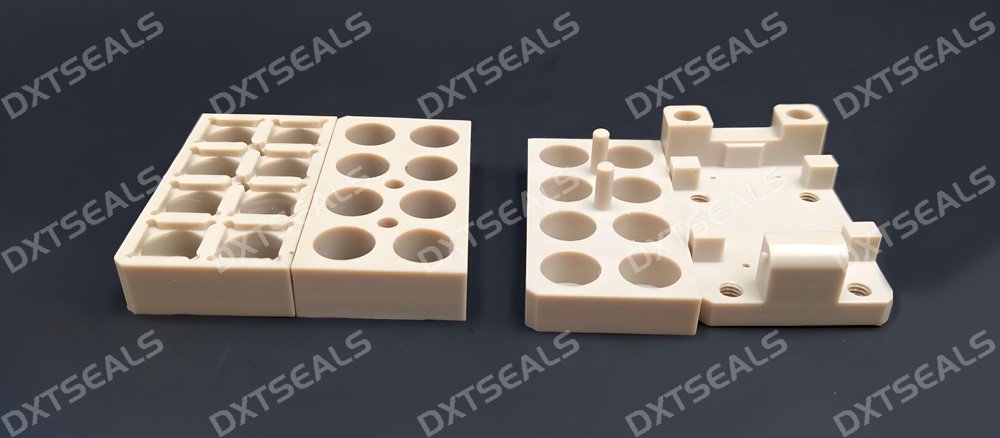
In the food processing industry, materials used in equipment must meet strict safety, hygiene, and durability standards. Polyetheretherketone (PEEK) has emerged as a high-performance polymer that meets these demands, offering excellent thermal stability, chemical resistance, and mechanical strength.
This article explores why PEEK is an ideal material for food processing equipment, highlighting its key benefits, regulatory compliance, and common applications.
1. Why PEEK is Perfect for Food Processing Equipment
PEEK is widely used in food and beverage manufacturing due to its exceptional performance in harsh environments. Some of its standout properties include:
- High-Temperature Resistance – PEEK can withstand continuous temperatures up to 250°C (482°F), making it ideal for high-heat applications such as ovens and sterilization processes.
- FDA and EU Compliance – Food-grade PEEK meets FDA (21 CFR 177.2415) and EU 10/2011 regulations, ensuring safe contact with food.
- Chemical and Corrosion Resistance – Resistant to strong cleaning agents, acids, and oils, making it easy to maintain hygiene.
- Non-Toxic and Biocompatible – Does not release harmful substances, ensuring food safety.
- Wear and Abrasion Resistance – Provides long-lasting durability in high-friction applications like conveyor belts and mixing components.
- Low Friction and Self-Lubricating – Reduces machine wear and minimizes the need for external lubricants, preventing food contamination.
2. Key Applications of PEEK in Food Processing Equipment
2.1 Bearings and Bushings
PEEK is used in bearings and bushings for its ability to:
✔ Operate under high loads without wear
✔ Resist harsh cleaning chemicals
✔ Function without additional lubrication
2.2 Seals and Gaskets
Seals and gaskets made from PEEK offer:
✔ Superior chemical resistance, preventing degradation from food acids and detergents
✔ High-temperature stability, ensuring airtight sealing in ovens and sterilization units
✔ FDA compliance, making them safe for direct food contact
2.3 Conveyor Components and Rollers
PEEK’s wear resistance and low friction make it an ideal material for:
✔ Conveyor rollers and belt guides, ensuring smooth food transport
✔ Food contact surfaces, reducing contamination risks
✔ High-speed automation parts, improving processing efficiency
2.4 Valve Seats and Pump Components
Food processing equipment relies on pumps and valves to handle liquids and semi-solids. PEEK components offer:
✔ Resistance to aggressive food ingredients and cleaning chemicals
✔ Superior dimensional stability, maintaining performance under pressure
✔ Extended service life, reducing maintenance downtime
2.5 Mixer and Blending Components
Mixing and blending operations require durable materials to handle:
✔ High-speed movement and impact forces
✔ Exposure to food acids, sugars, and oils
✔ Long-term performance in high-volume production
PEEK is often used for mixing paddles, stirring blades, and blending housings due to its high mechanical strength and food safety compliance.
3. PEEK vs. Traditional Materials in Food Processing
| Property | PEEK | Stainless Steel | PTFE (Teflon) | Nylon |
|---|---|---|---|---|
| Temperature Resistance | 250°C (482°F) | High | 260°C (500°F) | Moderate |
| Chemical Resistance | Excellent | High | High | Moderate |
| Wear Resistance | Very High | High | Low | Moderate |
| Food-Safe Compliance | Yes (FDA, EU 10/2011) | Yes | Yes | Some grades |
| Weight | Lightweight | Heavy | Very Light | Light |
| Self-Lubricating | Yes | No | Yes | No |
| Corrosion Resistance | Excellent | Prone to corrosion in acidic environments | Excellent | Moderate |
Why Choose PEEK Over Other Materials?
- More wear-resistant than PTFE, making it better for high-friction applications
- Lighter than stainless steel, reducing machine weight and energy consumption
- More chemical-resistant than nylon, ensuring long-term durability
4. Future Trends: PEEK in Next-Generation Food Processing Technologies
As food processing moves towards greater automation and efficiency, the demand for durable, food-safe, and low-maintenance materials is growing. Innovations in PEEK composites and coatings will continue to expand its applications in food machinery.
Key future trends include:
✔ 3D-printed PEEK parts, reducing production lead times
✔ Antimicrobial PEEK coatings, enhancing hygiene and food safety
✔ High-performance PEEK blends, offering even greater thermal and wear resistance
Conclusion
PEEK has become an indispensable material in the food processing industry, offering exceptional durability, food safety compliance, and resistance to harsh environments. Its high-temperature stability, chemical resistance, and low friction properties make it a superior choice over traditional materials.
For manufacturers seeking long-lasting, high-performance solutions, PEEK remains the top choice for food processing equipment.
